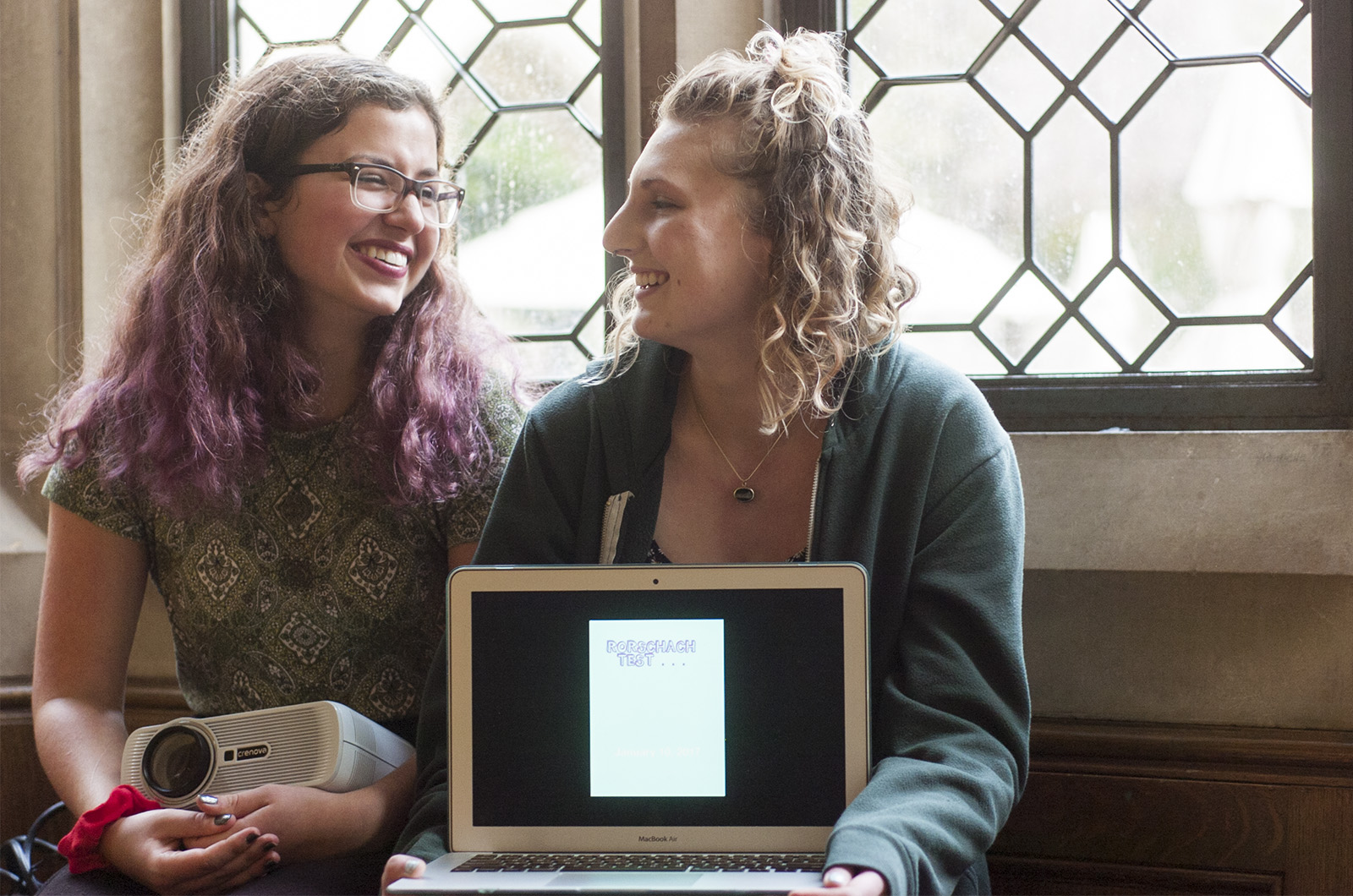Kerckhoff Art Gallery’s upcoming exhibit brings inkblot test into 3-D

Anna Mader and Ann Slote (left to right) helped organize an exhibit in the Kerckhoff Art Gallery that was inspired by a psychology assessment known as the inkblot test. The exhibition is meant to help viewers think about their self-identities. (Kristie Hoang/Daily Bruin)
By Linda Xu
Jan. 12, 2017 12:00 a.m.
Hypnotic shapes and neon outlines will move their way through a three-dimensional space against a stark white backdrop.
The images are reminiscent of the inky splotches of a Rorschach test – a psychology assessment commonly known as the inkblot test – which evoke different images personal to the individual examining them.
The interactive art exhibit “The Rorschach Test” in the Kerckhoff Art Gallery hopes to invite a similar introspection by showcasing animations that resonate differently with each viewer, said Laura Slote, fourth-year global studies student and programming director for the Undergraduate Student Association Council’s General Representative 3.
The event will be open Thursday through Saturday with different animation sequences displaying each night. The sequences involve abstract shapes and vivid colors to facilitate open interpretation. One animation depicts a moving landscape of sorbet-colored prisms, while another is centered on a swirling circular whirlpool encasing vibrant hues.
The imagery consolidates the efforts of six visual and graphic artists into one projection on display. The exhibit features projection mapping, technology that displays videos onto three-dimensional objects, to complement the event’s theme of mental heath and self-identity through abstract animations.
The exhibit’s artistic director Anna Mader wanted to reflect how people interpret an abstract inkblot in a variety of ways, and how interpretations are seen as a projection of one’s psychology or self-identity. Thus, the second-year theater student decided to reference the Rorschach test in the project’s title.
“We want people to be drawn in by the art and also through the art think about themselves and their own mental health,” said Slote.
“The Rorschach Test” uses projection mapping to display lights and animations onto two blank cubes, each face a foot wide, in the gallery, Mader said. Whereas traditional projectors display images on a flat surface, the computer program used for projection mapping allows artists to project images onto uneven surfaces to create depth. Mader was among the students to draft the animations displayed by the projector in the exhibit.
Using cubes as the projection surface enables the artists to display different scenes onto each side of the cube, said second-year theater student Ann Slote, who will be operating the projector during the event.
“The cool thing about projecting onto 3-D surfaces is that you can stand right next to it and you see the multiple sides that it has,” she said. “Just like how a brain has all of these different parts to it.”
The abstract quality of using graphic geometric sequences as opposed to a narrative storyline invites different interpretations of the art, followed by a self-examination of the viewer’s understanding of the art, much like how Rorschach’s inkblots reveal aspects of people’s psychology depending on how they interpret abstract images, Laura Slote said.
“You’re seeing something completely different from how someone else is seeing it,” Laura Slote said.
One of the animations in the exhibit features nets of neon blue triangles rotating and morphing into each other. Mader said she interprets when the shapes become one structure as the moment where one’s thoughts align. For another viewer, it may be perceived as an internal collision of feelings.
“For us, it’s not about what’s actually being projected, but what the meaning behind it is,” she said.
Another prominent theme of the exhibit is the disassociation between a person’s true psychology and what others assume or project onto them. The concept of using a literal projection will encourage viewers to reflect on their own self-identity and how they may project their own thoughts onto others, Mader said.
Unlike a film or a discussion panel, which involve students listening passively to speakers or videos, “The Rorschach Test” exhibit will emphasize individual interpretation, Laura Slote said.
By changing the animations each night and having people watch the projections in real time, the artists hope to engage and hold the viewer’s attention enough to think about their own mental health. Student counselors will be present at the event for people who want to learn more about mental health after seeing the exhibit.
“The artists are cool because you get to focus on the art,” Laura Slote said. “But for me, it’s what you’re thinking about the art, how the art affects you.”

